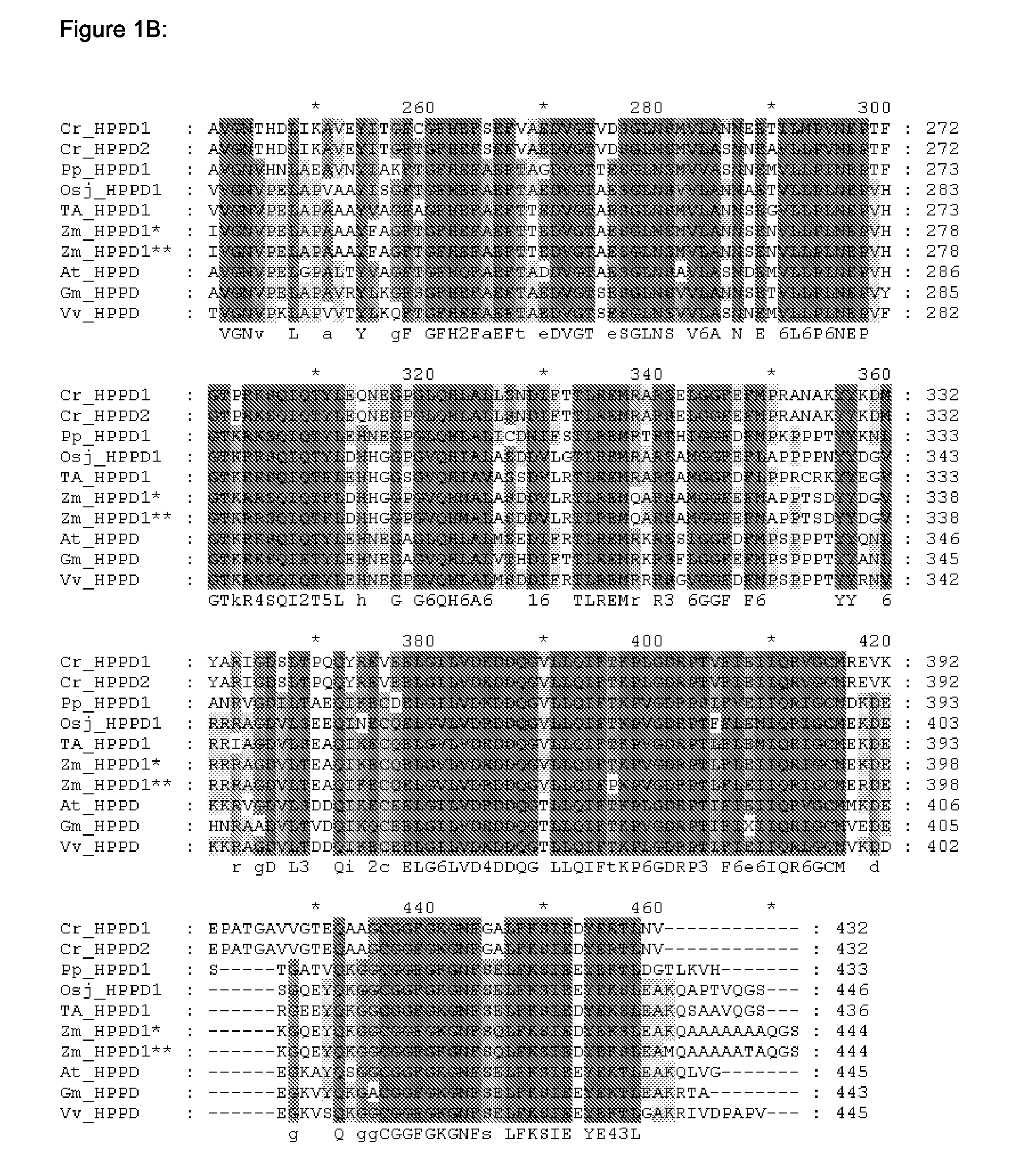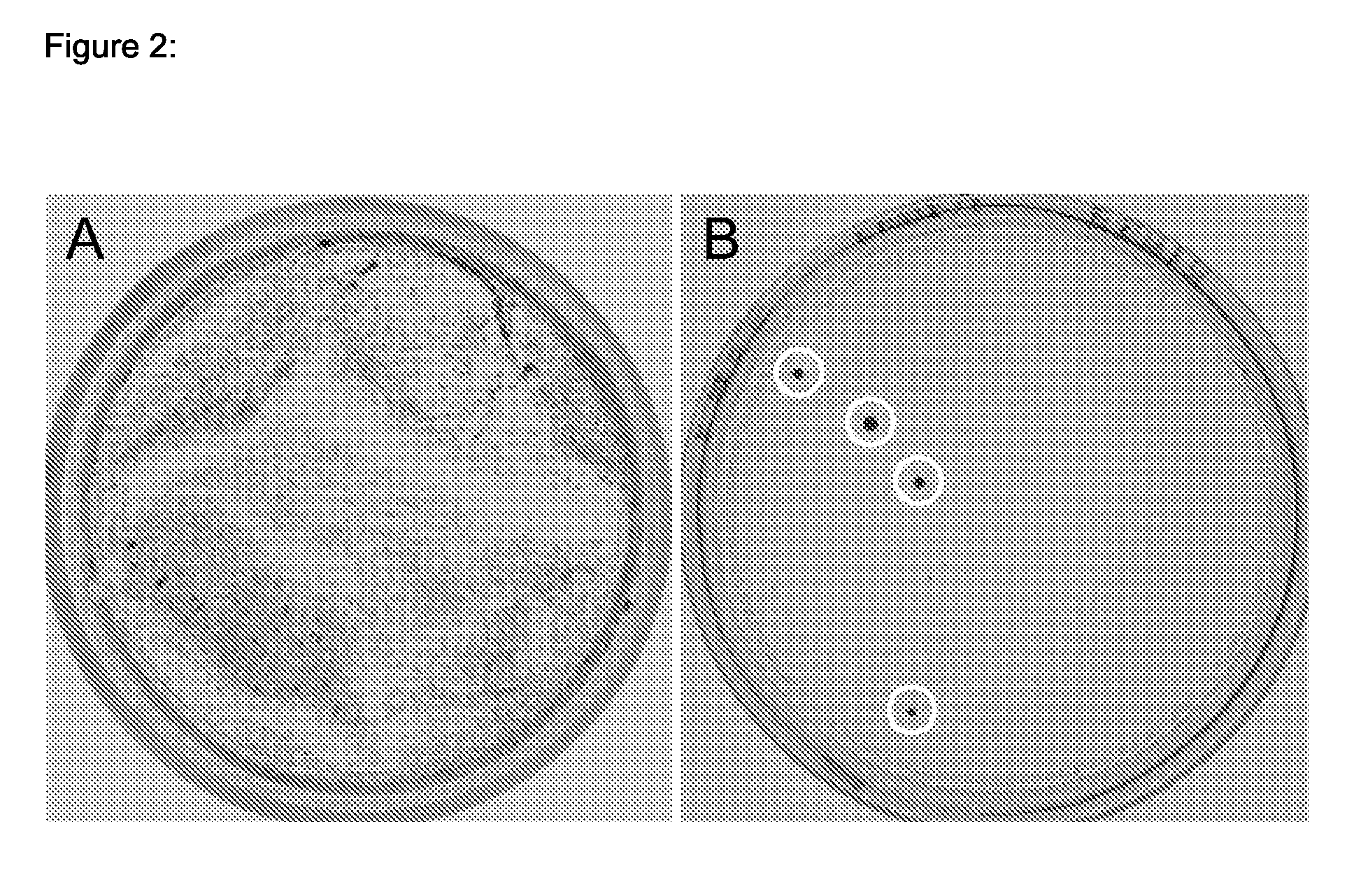Plants having increased tolerance to herbicides
a technology of herbicides and plants, applied in the field of plants having increased tolerance to herbicides, can solve the problems of chloroplast synthesis and function disturbance, oxidative degradation of chlorophyll and photosynthetic membranes in growing shoot tissues, and the symptoms of bleaching, etc., and achieve the effect of increasing the resistance to coumarone-derivative herbicides
- Summary
- Abstract
- Description
- Claims
- Application Information
AI Technical Summary
Benefits of technology
Problems solved by technology
Method used
Image
Examples
example 1
Cloning of HPPD Encoding Genes
(A) Cloning of Arabidopsis Thaliana HPPD
[0264]The partial Arabidopsis thaliana AtHPPD coding sequence (SEQ ID No: 1) is amplified by standard PCR techniques from Arabidopsis thaliana cDNA using primers HuJ101 and HuJ102 (Table 5).
TABLE 5PCR primers for AtHPPD amplification(SEQ ID NOs: 20, 21)PrimerPrimer sequencename(5′→ 3′)HuJ101GGCCACCAAAACGCCGHuJ102TCATCCCACTAACTGTTTGGCTTC
[0265]The PCR-product is cloned in vector pEXP5-NT / TOPO® (Invitrogen, Carlsbad, USA) according to the manufacturer's instructions. The resulting plasmid pEXP5-NT / TOPO®-AtHPPD is isolated from E. coli TOP10 by performing a plasmid minipreparation. The expression cassette encoding N-terminally Hiss-tagged AtHPPD is confirmed by DNA sequencing.
(B) Cloning of Chlamydomonas Reinhardtii HPPD1
[0266]The C. reinhardtii HPPD1 (CrHPPD1) coding sequence (SEQ ID No: 3) is codon-optimized for expression in E. coli and provided as a synthetic gene (Entelechon, Regensburg, Germany). The partial syn...
example 2
Heterologous Expression and Purification of Recombinant HPPD Enzymes
[0276]Recombinant HPPD enzymes are produced and overexpressed in E. coli. Chemically competent BL21 (DE3) cells (Invitrogen, Carlsbad, USA) are transformed with pEXP5-NT / TOPO® (see EXAMPLE 1) according to the manufacturer's instructions.
[0277]Transformed cells are grown at 37° C. in LB broth (Invitrogen, Carlsbad, USA) supplemented with 100 μg / ml ampicillin. Proteins are expressed without induction by IPTG (Isopropyl-D-1-thiogalactopyranoside).
[0278]At an OD600 (optical density at 600 nm) of 4 to 5, cells are harvested by centrifugation (8000×g). The cell pellet is resuspended in binding buffer (50 mM sodium phosphate buffer, 0.5 M NaCl, 10 mM Imidazole, pH 7.0) supplemented with complete EDTA free protease mix (Roche-Diagnostics) and homogenized using an Avestin Press. The homogenate is cleared by centrifugation (20,000×g). Hiss-tagged HPPD or mutant variants are purified by affinity chromatography on a HisTrap™ HP...
example 3
Assay for HPPD Activity
[0279]HPPD produces homogentisic acid and CO2 from 4-hydroxyphenylpyruvate (4-HPP) and O2. The activity assay for HPPD is based on the analysis of homogentisic acid by reversed phase HPLC.
Method (A)
[0280]The assay mixture can contain 150 mM potassium phosphate buffer pH 7.0, 50 mM L-ascorbic acid, 1 μM FeSO4 and 7 μg of purified enzyme in a total volume of 1 ml.
[0281]Inhibitors are dissolved in DMSO (dimethylsulfoxide) to a concentration of 20 mM or 0.5 mM, respectively. From this stock solution serial five-fold dilutions are prepared in DMSO, which are used in the assay. The respective inhibitor solution accounts for 1% of the assay volume. Thus, final inhibitor concentrations range from 200 μM to 2.5 nM or from 5 μM to 63 pM, respectively.
[0282]After a preincubation of 30 min the reaction is started by adding 4-HPP to a final concentration of 0.1 mM. The reaction is allowed to proceed for 120 min at room temperature. The reaction is stopped by addition of 10...
PUM
| Property | Measurement | Unit |
|---|---|---|
| Molar density | aaaaa | aaaaa |
| Fraction | aaaaa | aaaaa |
| Fraction | aaaaa | aaaaa |
Abstract
Description
Claims
Application Information
 Login to View More
Login to View More - R&D
- Intellectual Property
- Life Sciences
- Materials
- Tech Scout
- Unparalleled Data Quality
- Higher Quality Content
- 60% Fewer Hallucinations
Browse by: Latest US Patents, China's latest patents, Technical Efficacy Thesaurus, Application Domain, Technology Topic, Popular Technical Reports.
© 2025 PatSnap. All rights reserved.Legal|Privacy policy|Modern Slavery Act Transparency Statement|Sitemap|About US| Contact US: help@patsnap.com



